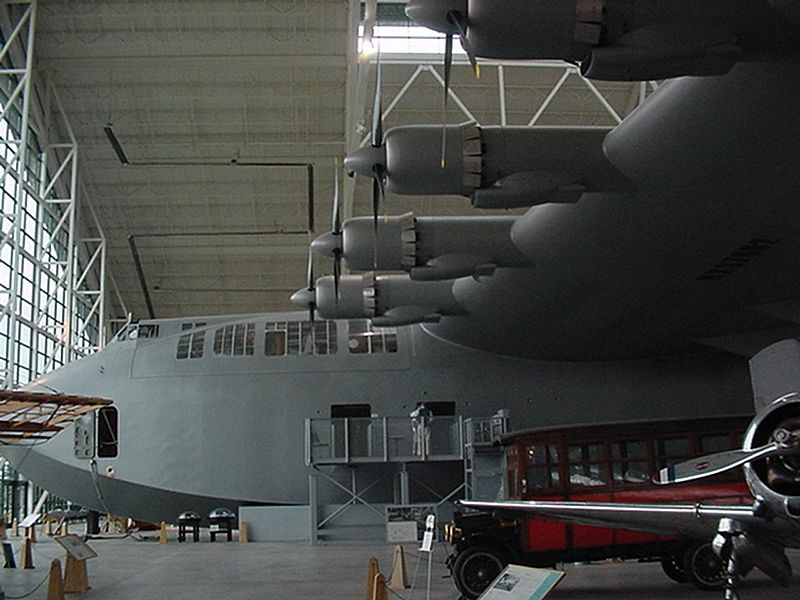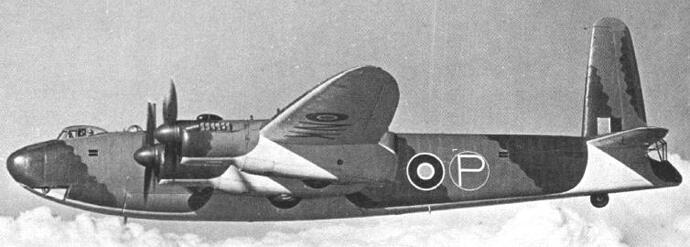1.Ju390
2.Spruce Goose
3.Nakajima G10N “projectZ”
4.Ta400
Big planes!
Er, were these planes actually active in ww2?
Id go for the Lancaster followed by a B-29…
Not active but interesting:
http://www.newsregister.com/ss/goose/StaffCoverage/GanderAtGoose_091900.html
The father of an Australian friend of mine was the pilot S-Sugar during WW2. Whenever he visits London, he makes his pilgrimage to Hendon. 
http://www.aikensairplanes.com/corgi/c32601.htm
http://au.youtube.com/watch?v=QEkBu5lDfAo&mode=related&search=
Hughes H-4 Hercules - “Spruce Goose”
http://en.wikipedia.org/wiki/Spruce_Goose
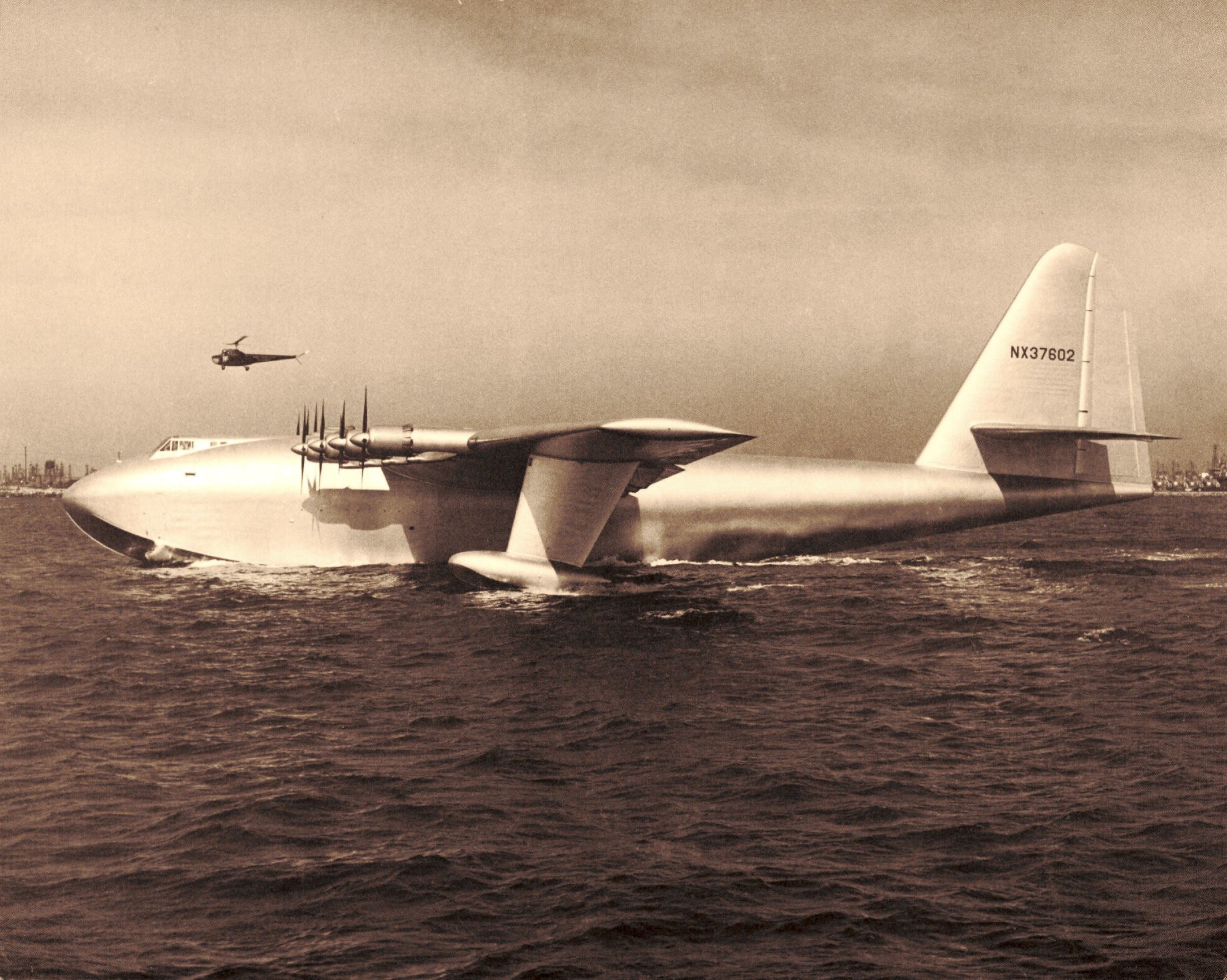
Size comparison between Hughes H-4 Hercules and a Douglas DC-3 Dakota
The Hughes H-4 Hercules (registration NX37602) is a “one-off” heavy transport aircraft designed and built by the Hughes Aircraft company, making its first and only flight on 2 November 1947. Built from wood due to wartime raw material restrictions to the use of aluminium, it was nicknamed the “Spruce Goose” by its critics, some of whom accused Howard Hughes of misusing government funding to build the aircraft. The Hercules is the largest flying boat ever built, and has the largest wingspan and height of any aircraft in history. It survives in good condition at the Evergreen Aviation Museum in McMinnville, Oregon.
http://www.sprucegoose.org/
http://www.aafo.com/goose/
Blohm & Voss BV 238
http://en.wikipedia.org/wiki/Blohm_%2B_Voss_BV_238

The Blohm & Voss BV 238 was a flying boat used in World War II. It was the heaviest aircraft ever flown when it first flew in 1944, and physically was the largest aircraft produced by any of the Axis powers in World War II. The BV 238 V1 prototype first flew on March 11, 1944 after a first jump on March 10th, 1944. Six 1750 hp (1.287 MW) DB 603 V12 engines built by Daimler-Benz were used in total, arranged in three forward facing integrated engine nacelles in a row on each wing.
Junkers Ju-390
http://en.wikipedia.org/wiki/Junkers_Ju_390
The Junkers Ju 390 was a long-range derivative of the Junkers Ju 290 and was intended to be used as a heavy transport, maritime patrol aircraft, and bomber. It was a design selected for the abortive Amerika Bomber project.
http://www.kheichhorn.de/html/body_junkers_ju_390.html
http://www.luftwaffephotos.com/lju3901.htm
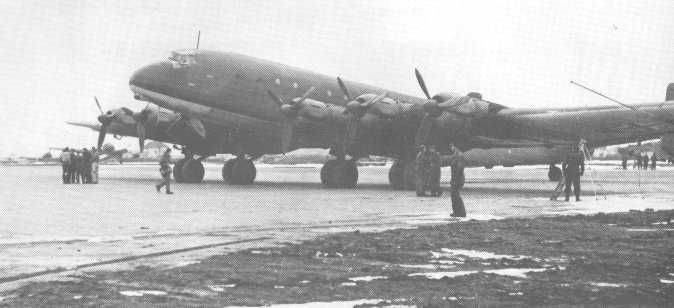
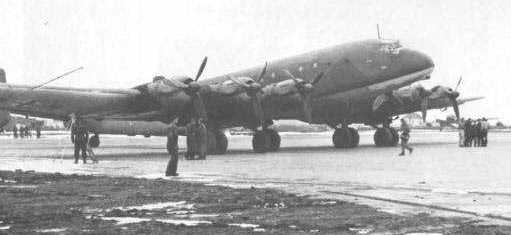
Focke-Wulf Ta 400
http://en.wikipedia.org/wiki/Focke_Wulf_Ta_400
The Focke-Wulf Ta 400 was a large six-engined bomber prototype developed in Germany in 1943 by Focke-Wulf as a serious contender to for the Amerika Bomber project. One of the first aircraft to be developed from components from multiple countries was also one of the most advanced Focke-Wulf design of World War II. Designed as a bomber and long range reconnaissance plane by Kurt Tank, the Ta 400 had a shoulder mounted wing with a 4 degree dihedral. One of the most striking features was the six BMW 801D radial engines and later two extra Jumo 004 jet engines.
http://luft46.com/fw/fwta400.html
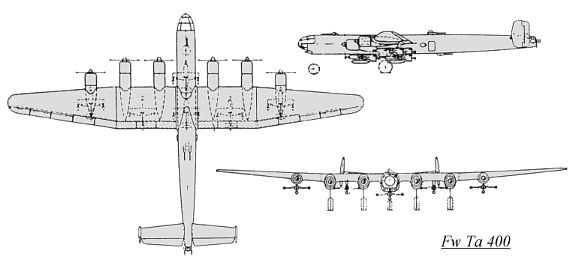
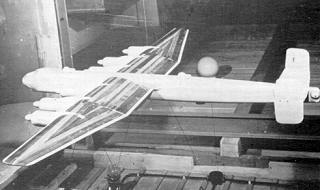
Nakajima G10N “projectZ”
http://en.wikipedia.org/wiki/Nakajima_G10N
The Nakajima G10N Fugaku (Japanese “Mount Fuji”), was a planned Japanese ultra-long range heavy bomber plane designed during World War II.
http://www.j-aircraft.org/xplanes/hikoki_files/g10.htm
http://www.samoloty.ow.pl/str042.htm


Victory Bomber
http://en.wikipedia.org/wiki/Victory_Bomber
The British “Victory Bomber” was a Second World War design by Barnes Wallis at Vickers-Armstrongs Aircraft for a bomber that could carry a single large earth quake bomb to targets in Germany.
The Victory bomber was proposed by aircraft designer Barnes Wallis to carry single large bombs that could cause massive destruction to strategic infrastructure targets in Germany. His reasoning was that by selectively destroying the German capacity to make armaments their war effort would be stopped. The design for the bomb came out at around ten long tons which was beyond the capacity of any current or in design Royal Air Force (RAF) bomber. Accordingly Wallis sketched out a bomber that would have to be built for the bomb.

Brooklands museum. The wind tunnel model of the Victory Bomber.
http://en.wikipedia.org/wiki/Barnes_Wallis
http://www.tgplanes.com/Public/snitz/topic.asp?TOPIC_ID=639
Douglas XB-19
http://en.wikipedia.org/wiki/Douglas_XB-19

The Douglas XB-19 was the largest bomber built for the United States Army Air Corps until 1946. It was originally given the designation XBLR-2 (XBLR- denoting Experimental Bomber, Long Range).
The purpose of the XB-19 project was to test the flight characteristics and design techniques associated with giant bombers. Douglas Aircraft Company strongly wanted to cancel the project, because it was extremely expensive. Despite advances in technology that made the XB-19 obsolete before it was even completed, the Army Air Corps felt that the prototype would be useful for testing. Its construction took so long that competition for the contracts to make the XB-35 and XB-36 occurred two months before its first flight.
The plane finally flew on June 27 1941, more than three years after the construction contract was awarded. In 1943, the original Wright R-3350 engines were replaced with Allison V-3420-11 V engines. After completion of testing, the XB-19 served as a cargo carrier until it was scrapped in 1949.
http://www.nationalmuseum.af.mil/factsheets/factsheet.asp?id=2489
http://www.nationalmuseum.af.mil/factsheets/factsheet.asp?id=2490

Convair B-36
http://en.wikipedia.org/wiki/Convair_B-36

XB-36 prototype alongside the B-29
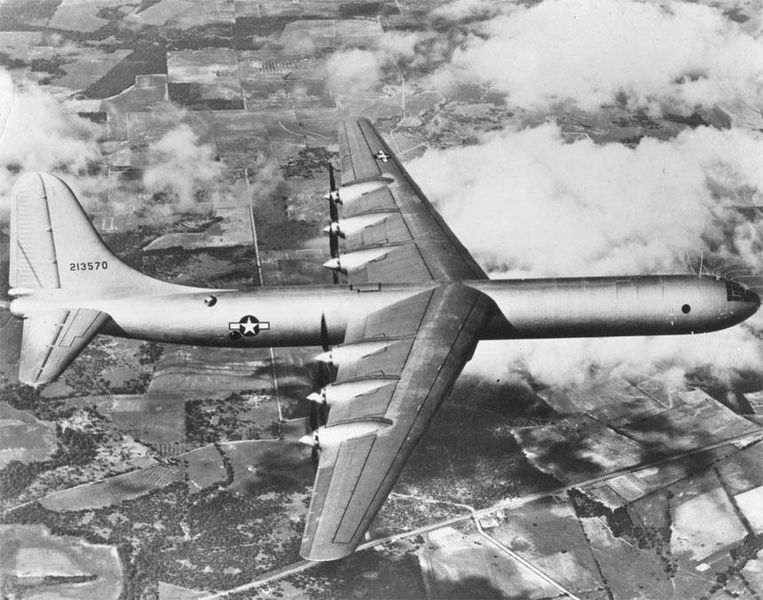
The XB-36 on its first flight.
The Convair B-36 (nicknamed the Peacemaker) was a strategic bomber built by Convair and operated solely by the United States Air Force (USAF). The B-36 was the largest mass-produced piston engined aircraft ever made and the largest combat aircraft ever built, although there have been larger military transports. The B-36 was the first thermonuclear weapon delivery vehicle. With a range of over 6,000 miles and a maximum payload of at least 72,000 lbs, the B-36 was the first operational bomber with an intercontinental range, setting the standard for subsequent USAF long range bombers, such as the B-52 Stratofortress and B-1 Lancer.
The genesis of the B-36 can be traced to early 1941, prior to the entry of the U.S. into World War II. At that time it appeared that there was a very real chance that Britain could fall, making a strategic bombing effort by the U.S. against Germany impossible. A new class of bomber would be needed to fill this role, one that offered trans-Atlantic range so that it could bomb targets in Europe from bases inside the continental USA. The United States Army Air Corps opened up a design competition for the very long-range bomber on 11 April 1941, asking for a 450 mph top speed, a 275 mph cruising speed, a service ceiling of 45,000 ft, and a maximum range of 12,000 miles at 25,000 ft. These proved too demanding for any short-term design, so on 19 August 1941 they were reduced to a maximum range of 10,000 miles, an effective combat radius of 4,000 miles with a 10,000 pound bombload, a cruising speed between 240 and 300 mph, and a service ceiling of 40,000 ft.
After the Cold War began in earnest with the 1948 Berlin airlift and the 1949 atmospheric test of the first Soviet atomic bomb, American military planners sought bombers capable of delivering the very large and heavy first-generation nuclear bombs. The B-36 was the only American aircraft with the range and payload to carry such bombs from airfields on American soil to targets in the USSR (storing nuclear weapons in foreign countries was, and remains, diplomatically sensitive).
The B-36 was arguably obsolete from the outset, being piston-powered in a world of jet interceptors.
http://home.att.net/~jbaugher2/b36.html
http://www.cowtown.net/proweb/b36net/
http://www.aerospaceweb.org/aircraft/bomber/b36/
http://www.zianet.com/tmorris/b36.html
http://www.nationalmuseum.af.mil/factsheets/factsheet.asp?id=2584
http://www.nationalmuseum.af.mil/factsheets/factsheet.asp?id=2537
http://www.pbs.org/wgbh/amex/bomb/filmmore/reference/interview/edmund10.html
B-29
Lancaster
Betty
He 177
Bv-222
H2K Emily
B-17
PS The “lighter” refers to the fact that the engins were prones to fires.
Also known as He 177 “Greif”
As if there weren’t enough spammers on the forum, we now have members doing it too.
Major Schmidt, this topic is virtually identical to your previous topic (the post below this) and contributes nothing to the forum. If you keep doing this, you will get a formal warning and potentially infraction points, etc.
Topic locked pending deletion.
Is that size comparison between the Spruce-Goose and the Dakota for real? If so, they must have had rather tiny pilots for the Dakota, or huge pilots for the Spruce-Goose.
An enormous yet beautiful aircraft, eh 
The Hughes H-4 Hercules (Spruce Goose) as seen from the Evergreen Aviation Museum.

Douglas DC-3 Dakota
http://cdn-www.airliners.net/photos/photos/7/2/7/0115727.jpg
http://www.airliners.net/open.file?id=0115727&size=M
http://www.airliners.net/info/stats.main?id=188
Size comparison between Hughes H-4 Hercules and a Douglas DC-3 Dakota
i preffer He 277, potentially to became the best bomber in europe.
i like the focke wulf ta 400
That photo of the B-29 and the B-36 reminded me of one I saw of a B-17 and a B-29 and a B-52. The Stratofortress totally dwarfed the B-29! I vote for the B-29, arguably the most advanced aircraft of WWII.
Why doesnt anyone like the G10n?
Ah yes, the Nakajima G10, it was to be powered by six 36 cylinder, turbine-assisted, counter-rotating prop 5000HP HA-54 engines that would have pushed the 63 metre wingspan craft nearly 20,000 kilometres with a 10,000 pound payload, or a maximum 40,000 pound payload for closer targets. I have a post about it on my site.
Troy
www.feldpost.tv
I LOVE the Ju 390!

Yes… supposedly reached 12 miles from NYC… More on that o my Ju390 conspiracy thread.
Somebody ought to build the G10N so we could all see it. The Japanese had no chance to.
The Vickers “Victory”:
estimated performance as of jan42 (when abandoned):
c50ton loaded weight
bomb load/range 14515kg over 3218km or 7258kg over 6436km
ceilings over target area would be 13260m and 13807m respectively.
cruise speeds outbound/homebound 438/544 468/
The homebound ceiling would be 15470m
The Barnes Wallis 10ton bomb was the only part of this project that was bulit. This bomb was expected to have an impact speed of 427m/s and penetrate 30m into the ground when dropped from 12200m.
Impressive ceiling, but the Ta 152H would have been ready (and needed) when the “Victory” could have been, perhaps rumours of the “Victory” amongst other British 1941/42 bomber thinking was partly responsible for that?
The British and Vickers went for second best and produced the more mediocre unpreussurized Windsor, which was too late to see service in WWII anyway. They seemed to loose interest in high altitude pressurized bombers during 1942. They were often quite focused on what could be ready in time to have a useful impact on the war, which they by early 1943 thought would last into the middle of 1946, and showed comparatively little interest in very expensive long term development programmes. This might give a hint at the time scale suspected for Victories in squadron service? (US industrial muscle made the B-29 programme a very expensive not-quite-as-long-term development).
No very big British wartime aircraft, but then again, the mortal enemy was quite close…
Guess the biggest British aircraft of the war was the Short Shetland, first flown dec1944.

I’m not usually that keen on Japanese technology from that era, but I really liked the Nakagima.
My vote is definitely with the Hercules Spruce Goose, however.

